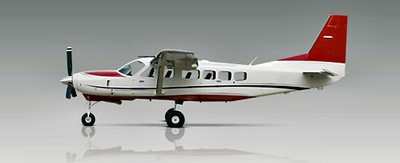A Witness In The Area Observed The Airplane Descending Rapidly “Straight Down,” Towards The Ground
Location: Youngstown, NY Accident Number: ERA24FA309
Date & Time: July 20, 2024, 11:40 Local Registration: N1259K
Aircraft: Cessna 208 Injuries: 1 Fatal
Flight Conducted Under: Part 91: General aviation - Skydiving

On July 20, 2024, about 1140 eastern daylight time, a Cessna 208B (file photo, below), N1259K, was destroyed when it was involved in an accident near Youngstown, New York. The commercial pilot was fatally injured. The airplane was operated by Skydive the Falls as a Title 14 Code of Federal Regulations Part 91 skydiving flight.
The accident occurred on the second day of the Skydive the Falls Fest Boogie (Falls Fest) which the operator held annually at Windsor Airport (63NY), Youngstown, New York. The pilot had completed 5 uneventful flights on the morning of the accident. The accident occurred during the 6th flight after the parachutists had departed the airplane without incident. According to preliminary air traffic control (ATC) communications obtained from the Federal Aviation Administration (FAA), at 1135, the pilot reported to Buffalo Approach West Radar control that the flight was 2 minutes prior to the jump. At 1140, the controller attempted to terminate radar services with the airplane but received no response. At 1144, another company airplane, who was attempting to locate the accident airplane, noted smoke on the ground about 2 to 3 miles west of the jump zone.
Review of preliminary ATC track data indicated that the airplane departed 63NY from runway 36, turned south and climbed to an altitude of 12,000 ft msl. The airplane subsequently made a jump pass from east to west over the airport. The track data ended near the west side of the airport, at 1139:20 at an altitude of 10,332 ft, an airspeed of 72 kts and a heading of 267º.
According to video imagery captured during the jump, after the skydivers departed the airplane, the airplane pitched over in a dive, and rolled right along its vertical axis before going out of view.
A witness in the area observed the airplane descending rapidly “straight down,” towards the ground. Another witness observed the airplane with “one wing pointed towards the ground,” and “one wing pointed towards the sky;” the airplane impacted the ground, and debris was thrown up on to a roadway.
Examination of the accident site and wreckage revealed that the airplane impacted a grassy slope adjacent to the Niagara Scenic Parkway in a left-wing, nose-low and near inverted attitude. A postimpact fire consumed most of the fuselage, the instrument panel, portions of the right wing and inboard section of the left flap. All primary and secondary flight control surfaces were identified except the inboard portion of the left flap. The outboard portion of the left flap exhibited thermal damage.

Flight control cable continuity could not be established due to the condition of the wreckage. One loose cable was observed with signatures consistent with tensile overload. The elevator and elevator trim tab cables were attached to the bellcrank in the empennage. Both elevator trim tab actuators measured 2.4-inches, which corresponded to approximately 15°-17° tab up or full nose down travel.
The left outboard elevator trim actuator screw assembly was bent upwards; the inboard actuator screw assembly was relatively straight. Both right elevator trim actuator screw assemblies were bent outboard; the outboard pushrod to the trim tab was fracture separated. The fuel system was mostly consumed by the postimpact fire. Both fuel caps were observed. The left cap was closed and secured to the left wing; the right cap was closed but loose from the wing.
The turbine section fracture separated from the engine. Multiple blades were bent opposite the direction of rotation and several blades were flattened against the turbine shaft and exhibited smearing.
The three propeller blades were separated from the hub, and the hub was not observed. One blade was located across the highway approximately 130 ft from the main wreckage. It was bent forward approximately 60° near the blade root and approximately 30° near the blade tip. The other two blades were located in the impact crater. One blade was bent forward at midspan with chordwise scratches on the blade back. The other blade was bent aft approximately 120° at the outer 1/3 of the blade with lengthwise scratches along the blade face. All three blades exhibited leading edge erosion.
The pilot had been flying for the operator since April 2024. Her most recent FAA first-class medical certificate was issued on July 31, 2023. As of July 2024, she had accrued about 1,449 total hours of flight experience, about 102 of which were in the accident airplane make and model.
According to FAA and airplane maintenance records, the airplane was manufactured in 2002. It had been modified via supplement type certificates (STCs) for parachute jump operations. The airplane's most recent 100-hour inspection was completed on March 24, 2024. At the time of the inspection, the airplane had accrued about 8,471 total hours of operation, and the engine had accrued about 1,050 hours since major overhaul.
The wreckage was retained for further examination.
 Aero-TV: DeltaHawks Diesel Power Steps Into the Spotlight
Aero-TV: DeltaHawks Diesel Power Steps Into the Spotlight NTSB Prelim: Mooney Aircraft Corp. M20K
NTSB Prelim: Mooney Aircraft Corp. M20K ANN FAQ: Turn On Post Notifications
ANN FAQ: Turn On Post Notifications ANN's Daily Aero-Linx (12.20.25)
ANN's Daily Aero-Linx (12.20.25) Aero-News: Quote of the Day (12.20.25)
Aero-News: Quote of the Day (12.20.25)




